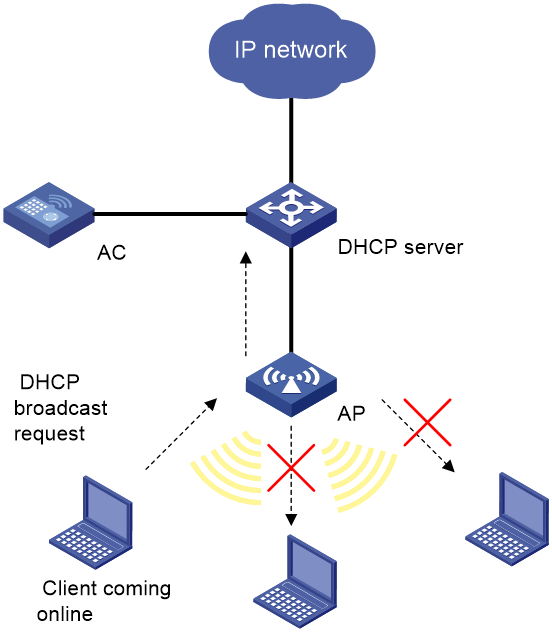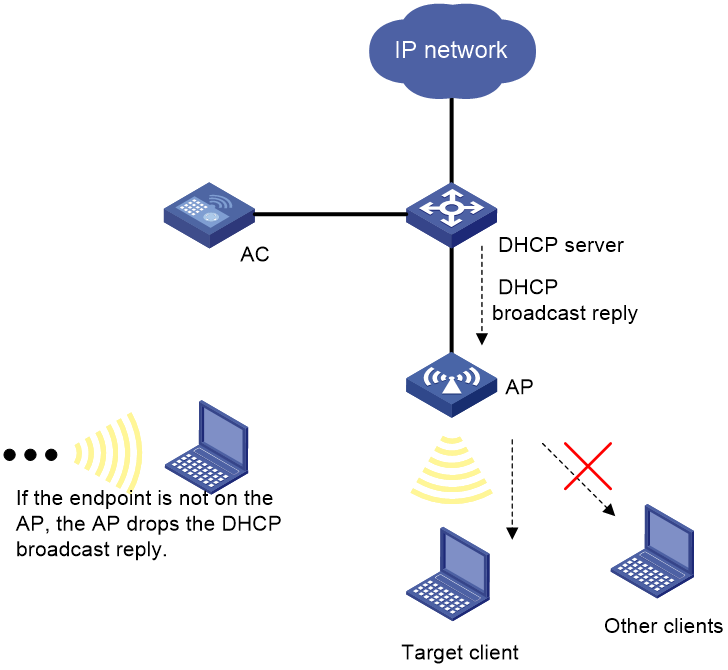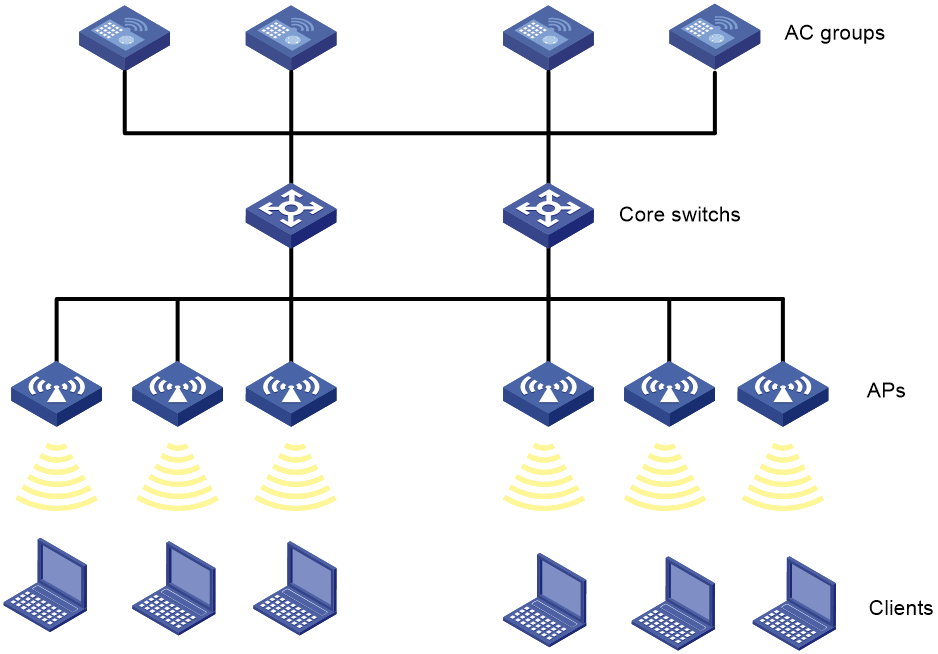- Released At: 15-09-2022
- Page Views:
- Downloads:
- Table of Contents
- Related Documents
-
|
|
|
Broadcast and Multicast Optimization Technology White Paper |
|
|
|
|
Copyright © 2022 New H3C Technologies Co., Ltd. All rights reserved.
No part of this manual may be reproduced or transmitted in any form or by any means without prior written consent of New H3C Technologies Co., Ltd.
Except for the trademarks of New H3C Technologies Co., Ltd., any trademarks that may be mentioned in this document are the property of their respective owners.
The information in this document is subject to change without notice.
Contents
Controlling IPv4 broadcast packets and multicast packets
Controlling IPv6 multicast packets
Dropping ICMPv6 multicast packets
Limiting the rate of broadcast packets and multicast packets
Dropping broadcast packets and multicast packets
Broadcast and multicast optimization
Overview
Technical background
In a wireless network, data is transmitted through channels. Both APs and endpoints contend for the use of channels. On a channel, only one device can send data at a time. In this case, broadcast packets and multicast packets affect the quality of the wireless network in multiple aspects:
· To ensure that broadcast packets and multicast packets are received and sent stably, the protocol specifies that the network transmits them at the lowest rate. Broadcast packets and multicast packets will slow down the transmission rate of the network.
· Broadcast packets and multicast packets are used to request a service or information. Many endpoints will receive broadcast packets and multicast packets. Typically, only one endpoint needs to respond. Unnecessary broadcast packets and multicast packets occupy wireless network and device resources.
· Many protocols send broadcast packets and multicast packets to the air interface and occupy many air interface resources. Network congestion will occur, and wireless network performance degrades.
Benefits
The WLAN broadcast and multicast optimization feature optimizes the wireless network in real time, reduces the impact of broadcast packets and multicast packets on the wireless network, optimizes air interface resources, and improves the data transmission efficiency.
Implementation
The WLAN broadcast and multicast optimization feature enables APs to reduce the number of broadcast packets and multicast packets forwarded by using the following methods:
· APs convert multicast packets to unicast packets.
· APs drop broadcast packets and multicast packets of protocols that air interfaces do not use.
· APs drop broadcast packets and multicast packets of unused services.
· APs limit the rate of broadcast packets and multicast packets that air interfaces send.
Controlling IPv4 broadcast packets and multicast packets
In an IPv4 wireless network, the most common broadcast packets are ARP packets and DHCP packets. The two types of broadcast packets need to be processed by only specific hosts, but are transmitted in the entire LAN. The WLAN broadcast and multicast optimization feature can drop the two types of broadcast packets or convert them to unicast packets.
|
|
NOTE: · Common ARP broadcast packets include gratuitous ARP packets, ARP requests sent by some endpoints, and ARP requests sent by a gateway. · Common DHCP broadcast packets include DHCP-DISCOVER messages and DHCP-REQUEST messages sent by clients. |
Processing ARP broadcast packets
An AP processes ARP broadcast packets received on air interfaces as follows:
· If the endpoint of the requested IP address is on the AP, the AP sends an ARP reply to the endpoint or converts the ARP request to a unicast packet.
· If the endpoint of the requested IP address is not on the AP, the AP drops the ARP request.
Processing DHCP broadcast packets
An AP processes DHCP broadcast packets as follows:
1. The AP sends the DHCP broadcast request from an endpoint to only the DHCP server and does not send the DHCP broadcast request to other endpoints.
Figure 1 Handling DHCP broadcast requests
2. The AP sends the DHCP broadcast reply to only the specific endpoint if that endpoint is on the AP.
If the endpoint is not on the AP, the AP drops the DHCP broadcast reply.
|
|
NOTE: Only some endpoints require that the DHCP server send a DHCP reply. |
Figure 2 Handling DHCP broadcast replies
Controlling IPv6 multicast packets
In an IPv6 wireless network, no broadcast packets exist, but a large number of multicast packets exist. ICMPv6 and DHCPv6 will send a large number of multicast packets, and these multicast packets need to be received only by the gateway or DHCP server. The IPv6 multicast packet control feature can drop the two types of multicast packets or convert them to unicast packets.
|
|
NOTE: · Common ICMPv6 multicast packets include RS packets, RA packets, NS packets, NA packets, and Redirect packets. · DHCPv6 multicast packets include only DHCPv6 packets. |
Processing RS packets
Router/prefix discovery allows an IPv6 node to find the neighboring routers and learn the prefix and network configuration parameters of the network from receiving RA messages.
A host can receive RA messages sent by the router periodically. Alternatively, the host can send RS packets and then receives RA packets from the router.
RS packets need to be received only by the router. An AP will drop RS packets received on air interfaces to prevent other hosts from receiving them.
Processing NS packets
IPv6 uses NS packets and NA packets for address resolution and address conflict detection.
An AP processes NS packets received on air interfaces as follows:
· If the endpoint of the requested IPv6 address is on the AP, the AP sends a reply to the endpoint or converts the NS packet to a unicast packet.
· If the endpoint of the requested IPv6 address is not on the AP, the AP drops the NS packet.
Processing ICMPv6 packets
ICMPv6 has 13 types of messages. Clients need to send ICMPv6 multicast packets to only the ICMPv6 server. An AP will drop ICMPv6 multicast packets received on air interfaces.
Dropping ICMPv6 multicast packets
By default, most endpoints are enabled with IPv6 and periodically send NS packets and RS packets for address and neighbor discovery. If you do not deploy IPv6 in your wireless network, you can drop ICMPv6 multicast packets received on air interfaces of an AP to save network resources.
Limiting the rate of broadcast packets and multicast packets
If air interfaces still receive a large number of broadcast packets and multicast packets after you enable dropping ICMPv6 multicast packets and you cannot locate or resolve the problem, you can configure this function. This function limits the number of broadcast packets and multicast packets sent to an air interface per second.
Dropping broadcast packets and multicast packets
In addition to ARP, DHCP, ICMPv6, and DHCPv6 packets, a network contains broadcast packets and multicast packets of other types for file sharing, printer sharing, screen casting, and multicast-on-demand. If the network does not need these services, you can use this function to drop all broadcast packets and multicast packets received on air interfaces except ARP broadcast packets.
Table 1 Broadcast packets and multicast packets in the network
|
Protocol |
Purpose |
|
Bonjour |
A Bonjour server sends mDNS packets to advertise the services that it provides. Bonjour clients can discover the Bonjour server without obtaining its information. This protocol is typically used for printer sharing and screen casting. |
|
SSDP |
SSDP is a LAN discovery protocol of Windows 7 and is the support protocol of UPnP. This protocol is typically used for P2P downloading in Thunder. |
|
NBNS |
This protocol is used to query the IP address of a computer name from a Windows server. |
|
LLMNR |
This protocol is used to resolve domain names between IPv6 hosts on a subnet that does not contain a DNS server. |
|
IGMP |
This protocol is used to establish and maintain the multicast group memberships between a Layer 3 multicast device and the hosts on the directly connected subnet. |
Application scenarios
Broadcast and multicast optimization
An enterprise wireless network is typically a large LAN and might contain hundreds of APs and more wireless endpoints. In addition to basic ARP and ND packets, the wireless network contains other broadcast or multicast packets, for example, Bonjour packets. Bonjour sends packets to discover services or advertise services it provides.
In this example, the wireless network is an IPv4 network. Perform the following tasks to reduce broadcast packets and multicast packets and to ensure forwarding of normal user traffic:
· Enable IPv4 broadcast and multicast control.
· Enable dropping IPv6 broadcast packets.
· Enable rate limiting for broadcast packets and multicast packets if a large number of broadcast packets and multicast packets still exist.




